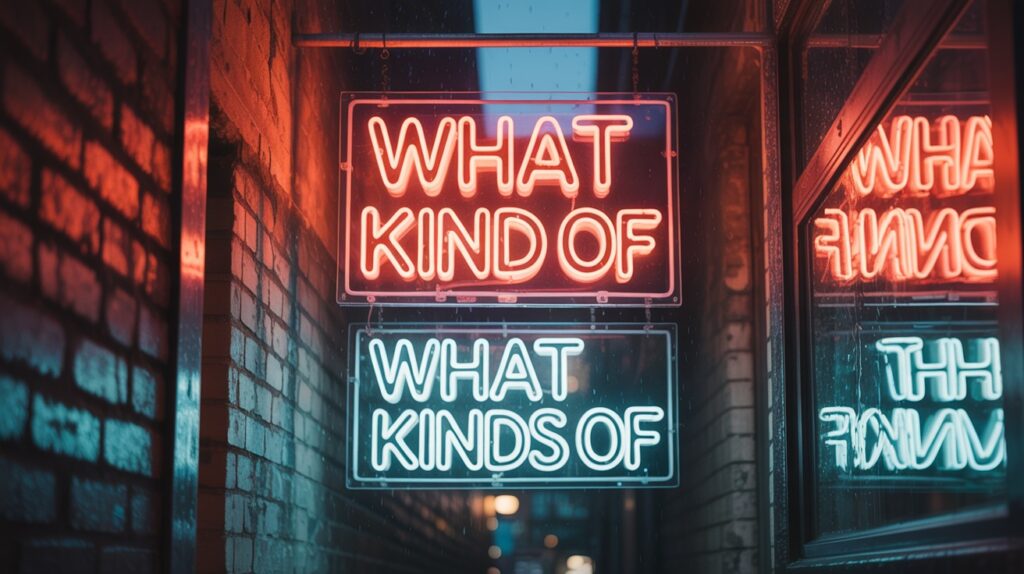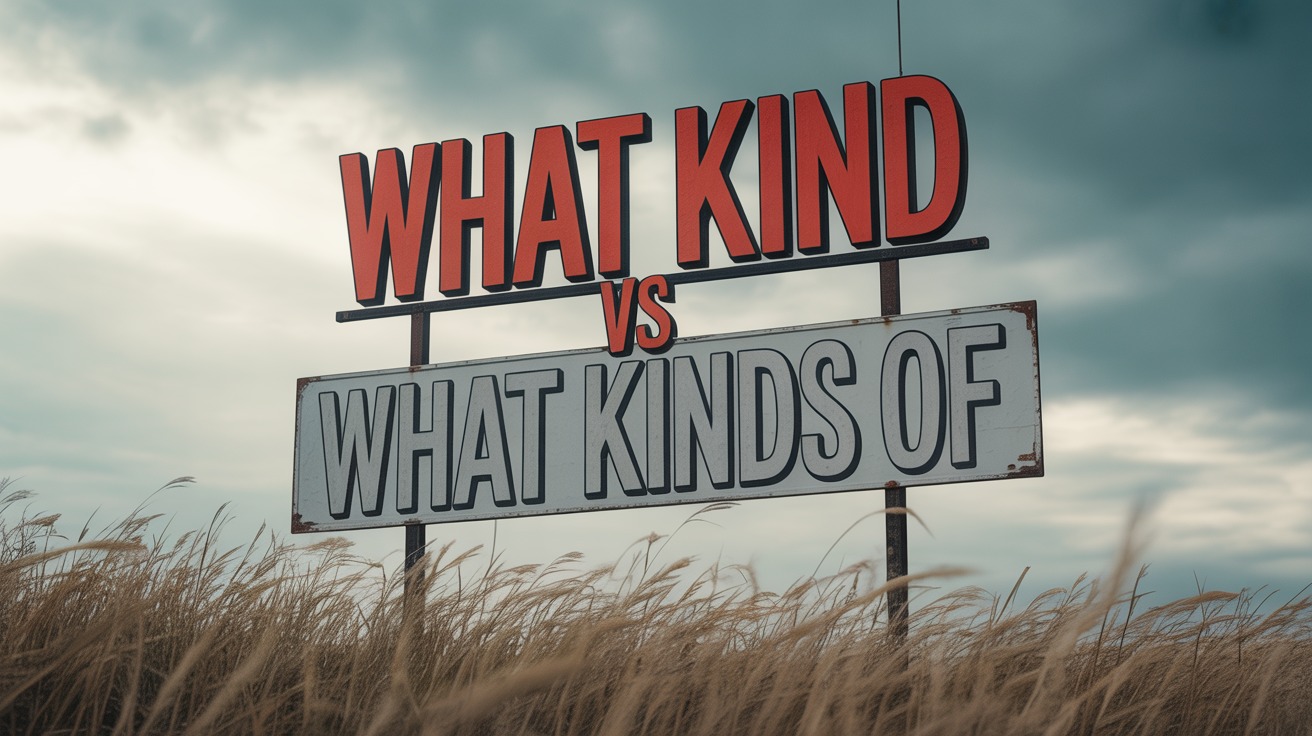Understanding the difference between “what kind of” and “what kinds of” is a crucial step for achieving fluency in English Grammar.
This 2025 Guide offers a complete breakdown to help English learners grasp the subtle differences between the two phrases, how to use them correctly, and when to choose one over the other. We’ll walk through real-world examples from classrooms, restaurants, cafes, zoos, and more.
Why This Confuses English Learners
It’s common to hear both “what kind of” and “what kinds of” in everyday English questions. But which one is right? The confusion often arises from not knowing whether the noun being used is singular, plural, or uncountable.
Grammar tip: Use “what kind of” with a singular noun or uncountable noun, and use “what kinds of” with a plural noun.
This basic rule supports better question phrasing in grammar, especially in casual conversations or formal writing alike.
Quick Grammar Rules (Table Format)
| Phrase | Use With | Example | Context |
|---|---|---|---|
| What kind of | Singular/Uncountable noun | What kind of coffee do you drink? | Café |
| What kinds of | Plural noun | What kinds of animals live in the zoo? | Zoo |
| What kind of | Specific type | What kind of software do you use? | Graphic Design |
| What kinds of | Multiple types | What kinds of books do you read? | Library |
Understanding this sentence construction helps you ensure clarity in speech and writing.
Understanding “What Kind of”
“What kind of” is used when asking about a specific type within a category, usually followed by a singular noun or an uncountable noun. It’s a key part of English question structure and used often in American conversational English.
Examples in Real Conversation
- Café: Anna: “What kind of coffee do you serve here?”
Barista: “We have Ethiopian, Colombian, and a house blend.” - Classroom: Teacher: “What kind of exercise helps improve flexibility?”
Student: “Stretching routines.” - Graphic Design Firm: Client: “What kind of logo style do you recommend?”
Designer: “Minimalist, especially for tech startups.”
This form helps identify type, refer to a category, and ask a question that narrows down information.
Exploring “What Kinds of”

Use “what kinds of” when referring to multiple types of things. This usually precedes a plural noun, and it’s great for exploring diversity or requesting lists.
Real Examples in Context
- Bakery: Customer: “What kinds of bread do you make?”
Baker: “Sourdough, rye, and whole wheat.” - Zoo: Tourist: “What kinds of animals are in this enclosure?”
Guide: “Lions, tigers, and leopards.” - Restaurant: Liam: “What kinds of salad dressing do you offer?”
Server: “Italian, Ranch, and Balsamic Vinaigrette.”
These examples show plural focus and support strong language nuance awareness.
ESL Grammar Examples for Clarity
For English learners, it’s critical to demonstrate fluency using these phrases correctly. Let’s break it down further:
Clarification – “What kind of music do you like?”
- Singular noun: “music”
- Seeks a specific type
- Context: Preference Inquiry
Exploration – “What kinds of food are popular in Lahore?”
- Plural noun: “foods”
- Broad list expected
- Context: Explore diversity
Specification – “What kind of job did you apply for?”
- Specific type, singular focus
Categorization – “What kinds of desserts do you bake?”
- Seeks list; plural noun
These examples improve language comprehension and help in effective speaking in English.
Ask the Right Types of Questions
Using the right question format enhances language structure in context. Here are some variations:
- What type of shoes do you wear to the gym?
- What style of music do you enjoy?
- What model of phone do you use?
- What flavor of ice cream is your favorite?
- What brand of jeans do you prefer?
Each option depends on contextual understanding and category vs variety selection.
Alternative Phrases for “Kind of”
Here are some phrase variations by context to expand your vocabulary:
- What sort of tools do you need?
- What categories of mistakes are most common?
- What examples of exercises do you recommend?
- What varieties of paint do you carry?
- What options of vacation spots are budget-friendly?
This enhances sentence clarity, supports writing clarity in English, and helps with vocabulary expansion.
Email Examples Using Each Phrase
Scenario 1 – Job Interview (Formal Event)
To: Sarah.Gilbert@company.com
Subject: Interview Preparation QuestionHi Sarah,
I’m preparing for my interview tomorrow and wanted to ask, what kind of questions should I expect from the panel?
Best,
Mark Chen
Scenario 2 – School Project
To: Mr.Daniels@classroom.edu
Subject: Science Fair SuppliesHello Mr. Daniels,
For our science booth, what kinds of materials can we use to build the prototype?
Regards,
Jennifer Morales
Singular vs Plural: Master the Usage
Let’s look at how to choose a phrase based on noun number:
- Singular noun → What kind of
- e.g., What kind of spice is this?
- Plural noun → What kinds of
- e.g., What kinds of spices do you use?
- e.g., What kind of paint is that?
Understanding countable vs uncountable nouns helps you master usage in all settings.
Common English Phrases in Use
Everyday usage examples include:
- Farmer’s Market: “What kinds of fruits are in season?”
- Library: “What kinds of books are on that shelf?”
All these improve your language precision and make your English phrase explanation more clear.
Curious Mentions – The Unexpected Terms
Sometimes, while learning phrases like what kind of vs what kinds of, you stumble upon intriguing side terms. Let’s clarify a few.
- Vagrant vs Hobo: While studying language nuance awareness, you might come across terms like these. Both refer to wanderers, but “hobo” implies someone looking for work while a vagrant typically isn’t.
- Demasculate: Often misused. It means to deprive a man of his male role or identity. Not to be confused with “emasculate.”
- What does count your days mean: A slang warning suggesting someone is nearing the end of patience or grace — often seen in pop culture.
- How tos: Guides that show steps, just like this article serves as a grammar how to for the phrase what kind if — a common typo.
Advanced Use Cases – AI and Language
Modern tools like Named Entity Recognition (NER) and Intent classification in chatbots rely heavily on grammar patterns in questions. Whether it’s paraphrase generation for language learning or context-aware response generation, understanding what kind of vs what kinds of enhances accuracy.
Even search engine semantic indexing depends on question form, modifier usage, and subject-verb agreement — all discussed above.
Final Thoughts: Choose Your Phrase, Ensure Clarity
To improve communication, you must understand when to use what kind of vs what kinds of. It’s not just about rules — it’s about real conversation, contextual understanding, and sounding fluent.
Whether you’re referencing music, food, books, or furniture, the key is to identify:
- Is the noun singular, plural, or uncountable?
- Are you asking for one specific type or a range of types?
This guide arms you with the tools to ask better questions, write with clarity, and grow your language fluency.
From The New Yorker to The Guardian, expert-level writing hinges on this kind of precision.
Now go ahead and use this English expression guide as your go-to for mastering the difference between kind and kinds — and level up your effective communication in any setting.

“Smith is the dedicated admin of [grammarprotips.com], a platform focused on enhancing grammar skills. With a passion for language and education, Smith strives to make grammar accessible and enjoyable for learners of all levels. Committed to delivering high-quality content, Smith continually explores innovative ways to help users master the complexities of grammar.”


js0etk
ghwt35
ilvb8g
vvybg4
1y947y
w6run6
utircp
rquj1h
nyqrv8
m1oi62
eqwfzq
w8jtqd
w8jtqd
hnwr10
p9y800
2gia0y
z9i33v
77dlo4
nqv1es